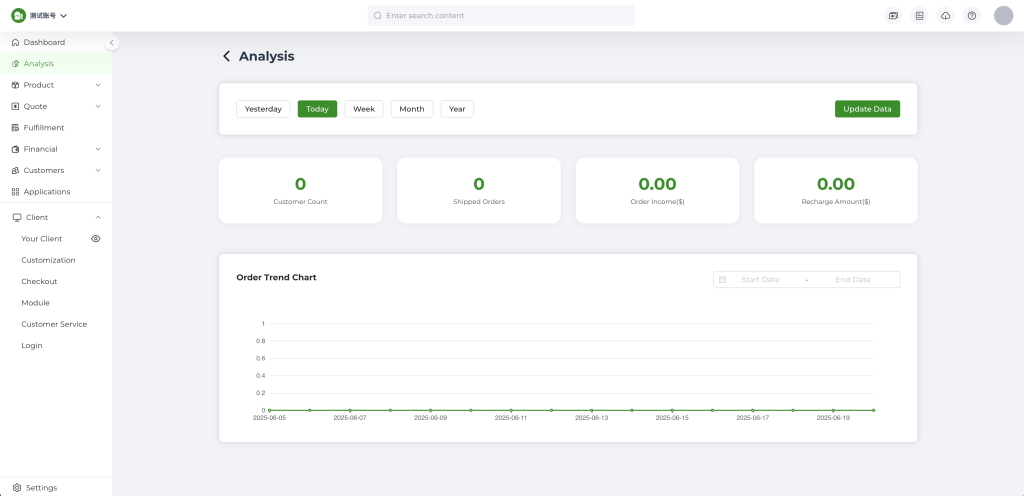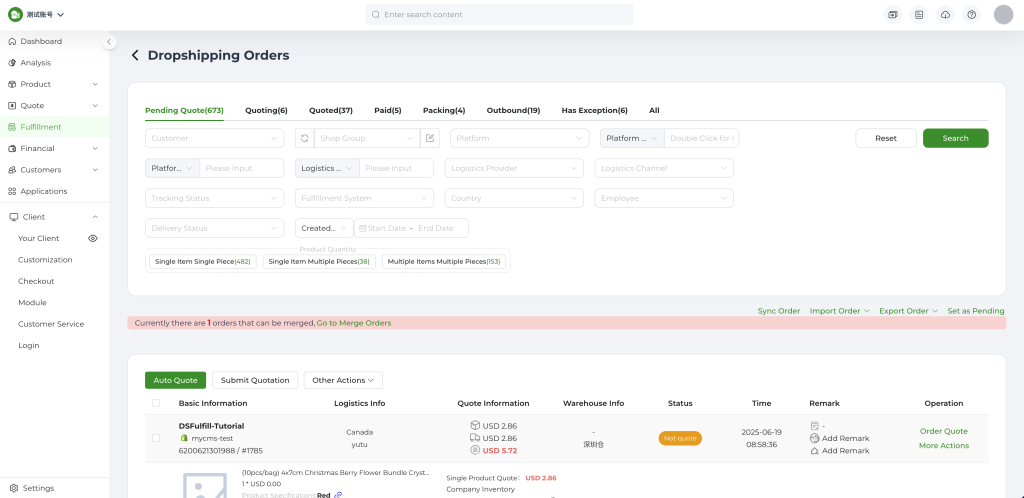Building an effective Dropshipping ERP (Enterprise Resource Planning) system requires addressing the diverse needs of both Dropshippers and Dropshipping Agents. While a previous article explored the essential features for Dropshippers—such as store management and product sourcing—this blog shifts focus to the Dropshipping Agent side. Agents, who serve as the operational backbone of the dropshipping ecosystem, face unique challenges, including order processing, procurement, and client management. As the dropshipping industry is projected to exceed $370 billion globally by 2025, a robust ERP tailored for Agents is critical. This guide outlines the key functionalities Agents need, optimized for efficiency and scalability, with insights into how DSFulfill supports these requirements.
The Role of a Dropshipping ERP for Agents
A Dropshipping ERP for Agents acts as a centralized management tool, streamlining workflows from product sourcing to order fulfillment and client support. Unlike traditional ERPs designed for retailers with physical inventory, a Dropshipping ERP must cater to the intermediary role of Agents, who coordinate between suppliers and Dropshippers across multiple platforms. With the rise of e-commerce—where over 60% of traffic now comes from mobile devices—Agents need a system that enhances productivity, reduces manual labor, and supports a global client base. This article details the essential features for the Agent management side, ensuring they can thrive in a competitive market as of June 20, 2025.
Key Features for Dropshipping Agents
2. Management Dashboard
2.1 Login
Agents require a secure login system using employee usernames and passwords, ensuring controlled access to sensitive data and operational tools.
2.2 Dashboard
- Today’s To-Do List: Displays pending tasks such as orders awaiting quotes, procurement, warehouse intake, and financial reviews, prioritizing daily workflows.
- Real-Time Statistics: Tracks key metrics like new users today, new users this month, and today’s recharge amounts, providing instant business insights.
- Charts: Visualizes recharge trends, user growth, and procurement order data through interactive graphs for strategic decision-making.
- Logs: Offers access to system integration logs for troubleshooting and monitoring API connections.
- Download Management: Manages records of downloaded files, ensuring efficient document handling and retrieval.

2.3 Product Management
2.3.1 Product Development
Enables Agents to add products, import product data in bulk, and manage product lists with full CRUD (Create, Update, Delete, Read) capabilities. Supports editing customs declaration information to comply with international shipping regulations.
2.3.2 Product Categorization
Allows creation, modification, and deletion of product categories, with multi-language translation settings to cater to diverse markets.
2.3.3 Hot Product Management
Facilitates bulk listing and delisting of hot-selling products in a dedicated library, enabling Dropshippers to publish these items to their stores seamlessly.
2.3.4 Product Collection Management
Supports binding 1688 procurement accounts to collect product links via URLs, streamlining the sourcing process from this key platform.
2.3.5 Client Product Quoting
Manages quotes initiated by clients, linking them to specific SKUs, with filtering options based on various conditions for efficient pricing adjustments.
2.4 Order Management
2.4.1 Order List
Provides a comprehensive view of all client orders, categorized by statuses such as Pending Quote, Quoting, Pending Payment, Paid, Preparing, Shipped, Exceptional, Not Shipped, and All. Supports advanced filters, order synchronization, manual pulls, imports, exports, automated quoting, manual quoting, employee assignments, and order tagging.

2.4.2 Sourcing Quotation
Manages client-initiated sourcing requests, allowing manual quote creation, claim assignment, allocation, submission, and deletion for flexible pricing.
2.4.3 SKU Quoting
Oversees SKU-specific quotes, supporting personalized pricing per client or country, with options to input profit margins.
2.4.4 Pre-Stock Orders
Tracks pre-stock order demands, integrating procurement and intake processes, with statuses including All, Pending Payment, Pending Processing, Pending Intake, Completed, and Canceled.
2.4.5 Customer Support Tickets
Manages client-raised support tickets, enabling responses, processing, and completion status updates to address after-sales issues efficiently.
2.4.6 Bundle Discounts
Allows Agents to set combination product discounts for clients, offering fixed amounts or percentage-based reductions to boost sales.
2.4.7 Order Packaging
Handles order parcel management, supporting order splitting/merging, shipping label requests, preparation status updates, and shipment tracking.
2.5 Procurement
2.5.1 Procurement Planning
Manages procurement plans with CRUD functionality, converts plans to purchase orders with one click, and filters by statuses like All, Draft, Pending Procurement, and Processed.
2.5.2 Purchase Orders
Generates purchase orders based on staff and procurement accounts, supporting manual and 1688 automated purchasing, with statuses including All, Pending Order, Ordered, Pending Intake, Completed, Exceptional, and Canceled.
2.5.3 Supplier Management
Configures supplier details such as name, ID, type, website, contact, payment terms, and bank account information for streamlined coordination.
2.5.4 Supply Relationships
Establishes links between products and suppliers, enabling searches or additions by SKU for efficient supply chain management.
2.6 Warehouse Management
2.6.1 Warehouse Inventory
Displays product stock levels, including total, available, locked, and owner-specific inventory, with search options by name or SKU.
2.6.2 Bin Inventory
Tracks SKU inventory by warehouse bin locations, organized by zone and position for precise stock monitoring.
2.6.3 Inventory Ledger
Records all stock movement history, detailing inbound and outbound transactions for accountability.
2.6.4 Inventory Audit
Manages stock audits with statuses like All, Pending Audit, In Progress, Completed, and Voided to ensure accuracy.
2.6.5 Inbound Orders
Handles inbound record management, supporting keyword searches, order creation, receipt signing, and shelving.
2.6.6 Inbound Receipt
Facilitates direct receipt signing based on inbound orders for efficient processing.
2.6.7 Inbound Shelving
Assigns received goods to designated bins based on inbound orders.
2.6.8 Shipment Management
Oversees picking orders, supporting wave picking, third-party logistics integration, label downloads/prints, shipping manifests, and Shopify logistics sync.
2.6.9 Wave Picking
Generates picking lists by wave, assigns staff, and prints lists for organized fulfillment.
2.6.10 Secondary Sorting
Enables sorting by picking lists and barcodes, auto-completing upon finish with automatic label printing.
2.6.11 Weighing
Links outgoing parcels to electronic scales for accurate weight recording.
2.7 Logistics
2.7.1 Freight Calculation
Estimates shipping costs by destination, delivery zone, weight, dimensions, and email, identifying available logistics channels.
2.7.2 Logistics Authorization
Integrates with over 20 logistics providers (e.g., YunTu, YanWen, YiDa, FeiTe, ShunYou, WanBang, EasyReach, China Post) via API accounts.
2.7.3 Freight Templates
Manages shipping templates with first-weight/continuation-weight or tiered-weight models, plus client-group pricing.
2.7.4 Common Customs Data
Stores reusable customs templates for order declarations.
2.7.5 Logistics Tracking
Connects to 17Track API for real-time shipment tracking.
2.8 Finance
2.8.1 Recharge Records
Manages client recharge details, supports quick recharges, requires financial review for offline payments, and allows record exports and invoice generation.
2.8.2 Commission Management
Handles affiliate marketing withdrawal requests, processes applications, and manages status tracking.
2.9 Client Management
2.9.1 Client Records
Manages client profiles, sets discounts, assigns staff, and tracks consumption data (balance, total spend, credit limit) with manual deductions and logs.
2.9.2 Client Segmentation
Groups clients by type with CRUD functionality for organized management.
2.9.3 Client Stores
Manages bound client stores, supporting tax ID settings (e.g., EU, UK VAT).
2.9.4 Marketing Campaigns
Monitors affiliate marketing efforts and client promotion performance.
2.10 Configuration
2.10.1 Staff Management
Adds, modifies, and toggles employee account access, assigning them to groups.
2.10.2 Role Permissions
Manages role-based access for employee groups, defining specific privileges.
2.10.3 Payment Settings
Configures online payment gateways, transfer details, and preset recharge amounts.
2.10.4 Warehouse Settings
Supports multi-warehouse management with bin allocation.
2.10.5 1688 Procurement Accounts
Adds 1688 account permissions for product searches and automated purchases.
2.10.6 Basic Settings
- System Configuration: Sets balance notifications, product development workflows, order templates (dropshipping + pre-stock or pre-stock only), and sync rules.
- 1688 Pricing: Configures markup rules.
- Currency Management: Supports manual/automated exchange rate updates and currency additions.
- Country Settings: Manages supported regions.
- Email Setup: Configures SMTP and message templates.
- Quoting Rules: Defines profit calculations for products, logistics, and orders.
- ERP Integration: Connects with MaBang and Dianxiaomi ERPs.
- Cloud Storage: Sets up video cloud drives.
2.10.7 Client Interface Configuration
- Branding: Customizes logos, system names, favicons, login ads, and URLs.
- Custom Menus: Adjusts client-side menu options.
- Privacy Policy: Manages privacy terms.
- Other: Adds support contacts, WhatsApp, and promotion links.
2.10.8 Message Settings
Creates system notifications for all or selected users.
2.10.9 Personal Profile
Updates personal details, passwords, and invoicing information.
Why DSFulfill Excels for Dropshipping Agents
DSFulfill, a leading Dropshipping ERP, is designed to meet these comprehensive needs, offering a scalable, user-friendly platform for Agents. With features like automated quoting, 1688 integration, and multi-warehouse support, DSFulfill reduces manual effort and enhances operational efficiency. Its compatibility with over 60% mobile-driven e-commerce traffic ensures Agents can manage tasks on the go, aligning with 2025 trends.
Conclusion
A Dropshipping ERP for Agents must include robust management, product, order, procurement, warehouse, logistics, finance, client, and configuration tools to handle the complexities of the role. As of June 20, 2025, DSFulfill stands out by offering these features in a cohesive, scalable package, empowering Agents to thrive in the $370 billion dropshipping market. Start using DSFulfill today to streamline your operations and elevate your Dropshipping Agent business!


